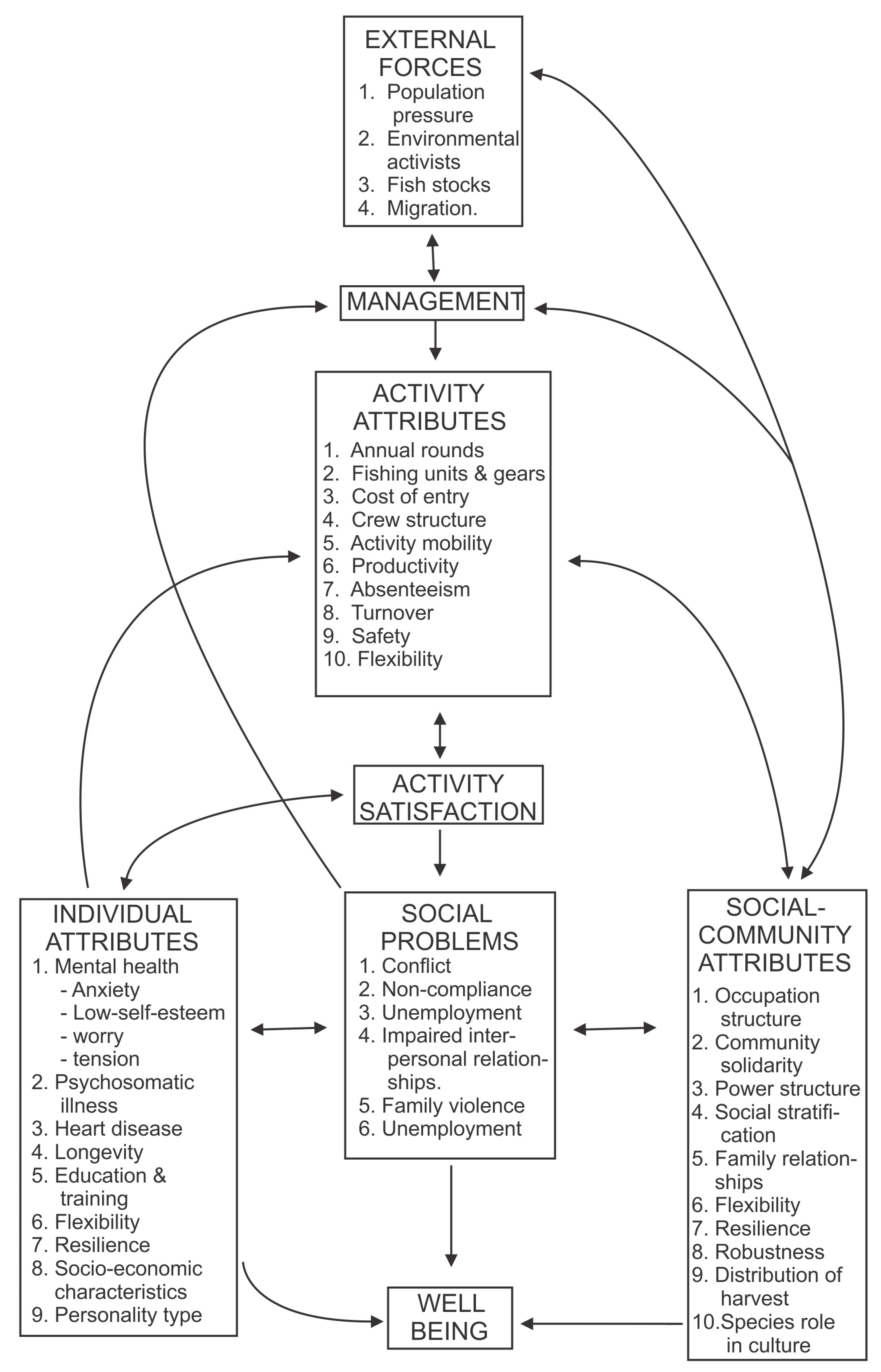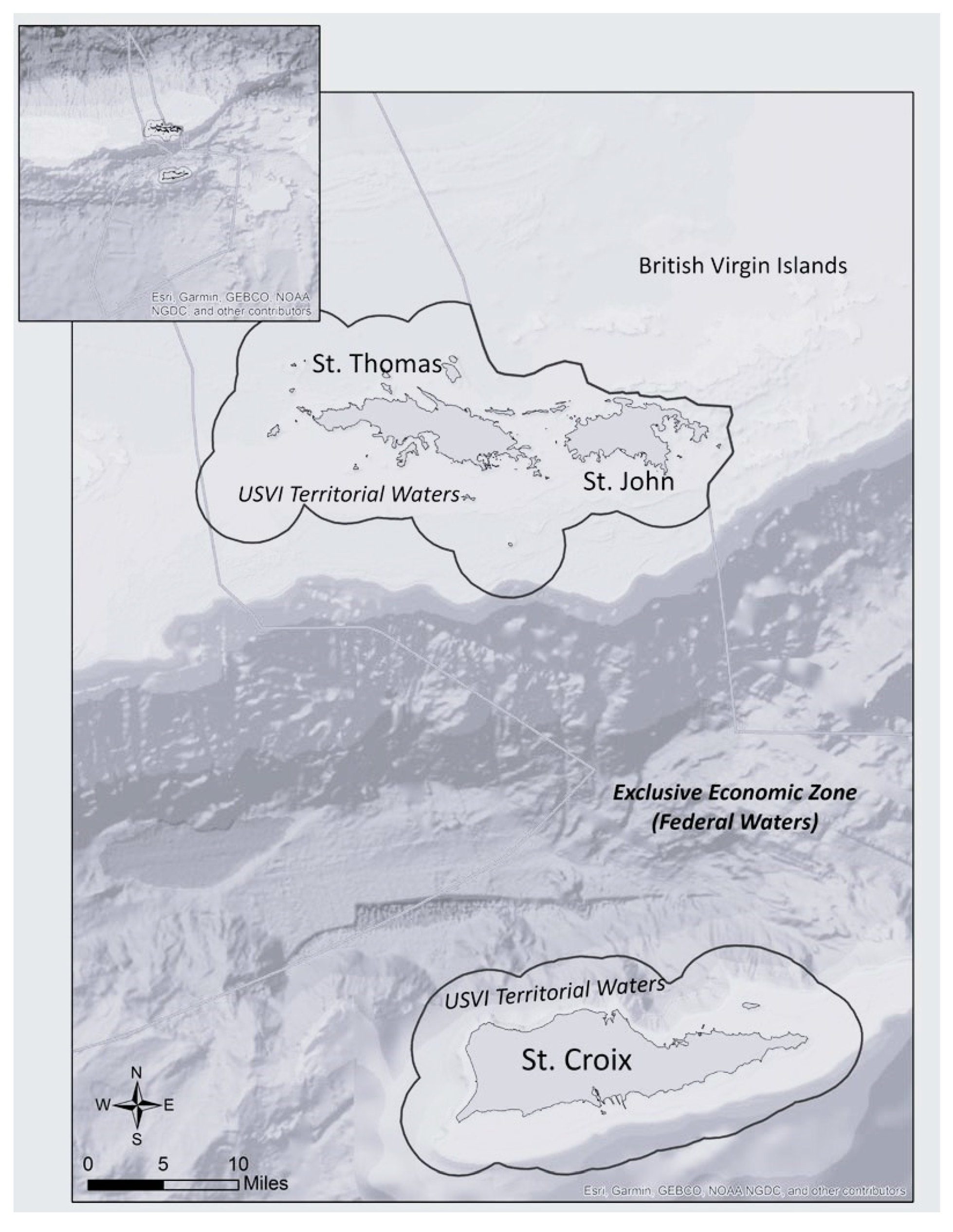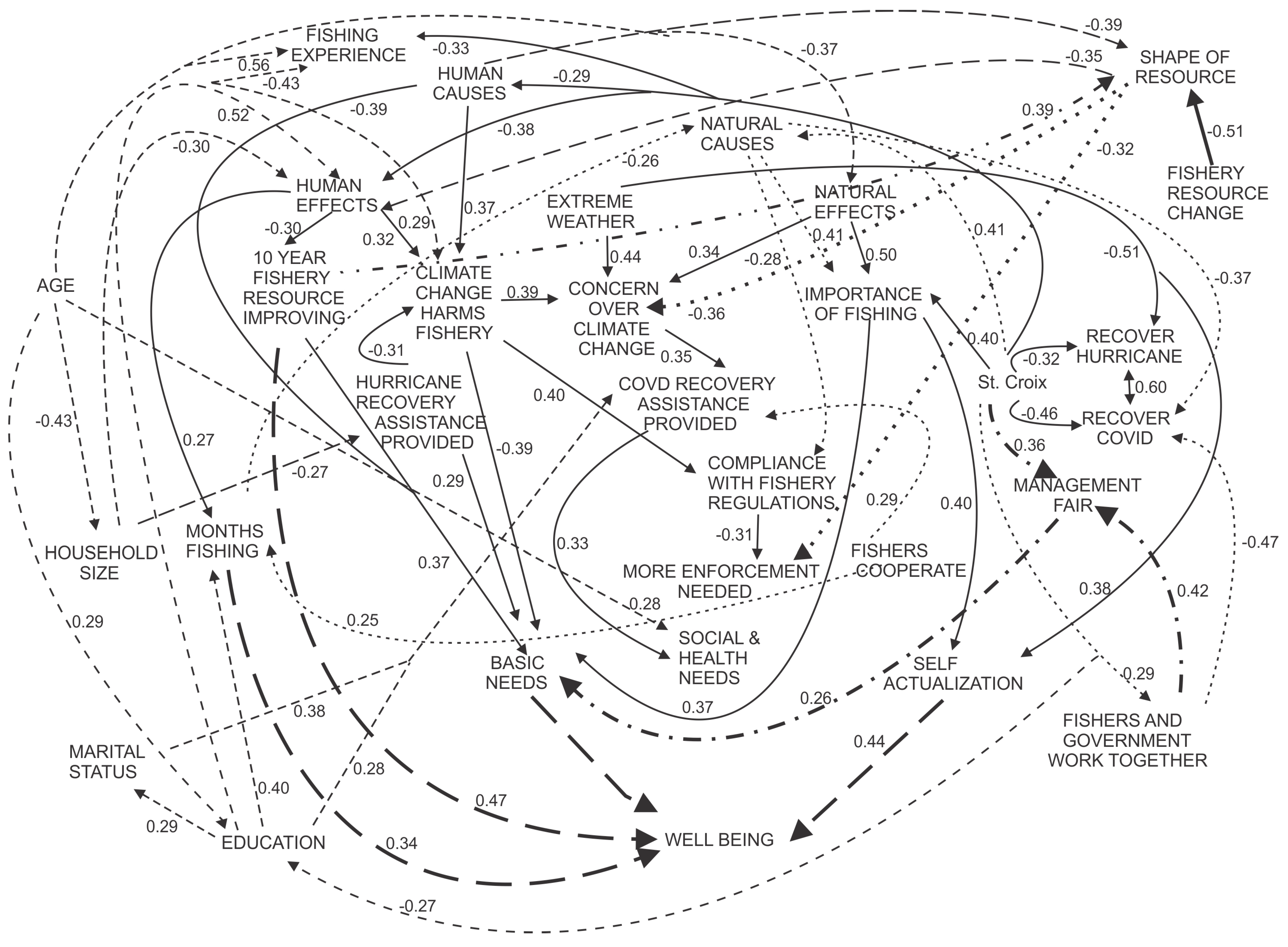Understanding Factors Affecting Fishers’ Wellbeing in the U.S. Virgin Islands through the Lens of Heuristic Modelling
Abstract
1. Introduction
U.S. Virgin Islands Fisheries
2. Methods and Analysis
2.1. Data Collection
2.2. Measures
2.2.1. Fishers’ Environmental Beliefs
2.2.2. Perceived Environmental Risk to Fishing Activity
2.2.3. Job Satisfaction Measures
2.3. Heuristic Modeling
3. Findings and Discussion
3.1. Factors Directly Affecting Fishers’ Wellbeing
3.2. Factors Influencing Fishers’ Perceptions of Risk and Environmental Beliefs
3.3. Factors Influencing Fishers’ Perceptions of Climate Change and Natural Disasters
3.4. Factors Influencing Fisher’s Perceptions on Governance/Management
4. Conclusions
- The relationships found between fishers’ perceptions of the health of fishery resources and their wellbeing and job satisfaction further support the importance of considering fishers’ wellbeing as an important indicator of ecosystem health. Further understanding these relationships can help to support EBFM development in the region by including monitoring and incorporation of human dimension variables that align with the needs and interests of fishers, thus increasing stakeholder buy in (Karp et al. 2023).
- Fishers’ knowledge and awareness of the impacts of environmental and climate change on fishery resources, including that of storms and hurricanes, as clearly evidenced by the correlations found in the model, provide evidence for the importance of local ecological knowledge (LEK) that can be used to complement management and decision making. Under EBFM, the need to understand and conceptualize ecosystem-level relationships further unmasks scientific data limitations; thus, LEK can be an important source of information for decision making, particularly in data-poor conditions such as that of the U.S. Caribbean region (Appeldoorn 2008).
- Higher fishing frequency, used here as a proxy for dependency, and higher levels of education were found to be associated with heightened environmental and climate awareness, suggesting that different aspects of experience and exposure to information affect perceptions of ecosystem change. In addition, fishers who expressed more concern over environmental changes were also more likely to support the need for more enforcement and compliance with rules and regulations to manage fishery resources. This information can be used to support and develop outreach and education strategies in collaboration with fishers and fishing communities. This can be particularly useful at the initial stages of EBFM development to increase understanding and support for new management approaches.
- Relationships found between job satisfaction variables and hurricane assistance, as well as community cohesiveness perceptions and COVID-19 assistance, point to the importance of developing effective, timely, and collaborative assistance programs to aid fishers and fishing communities in the aftermath of disaster events, as well as to promote long-term resilience and adaptation.
Author Contributions
Funding
Institutional Review Board Statement
Informed Consent Statement
Data Availability Statement
Acknowledgments
Conflicts of Interest
References
- Alongi, Daniel M. 2015. The Impact of Climate Change on Mangrove Forests. Current Climate Change Reports 1: 30–39. [Google Scholar] [CrossRef]
- Appeldoorn, Richard S. 2008. Transforming reef fisheries management: Application of an ecosystem-based approach in the USA Caribbean. Environmental Conservation 35: 232–41. [Google Scholar] [CrossRef]
- Asher, Herbert B. 1976. Causal Modeling. Beverly Hills: Sage Publications. 80p. [Google Scholar]
- Baker, Andrew C. 2014. Climate Change: Many Ways to Beat the Heat for Reef Corals. Current Biology 24: R1166. [Google Scholar] [CrossRef] [PubMed]
- Beauchaine, Theodore P., and Lisa M. Gatzke-Kopp. 2012. Instantiating the multiple levels of analysis perspective in a program of study on externalizing behavior. Development and Psychopathology 24: 1003–18. [Google Scholar] [CrossRef] [PubMed]
- Blalock, Hubert M. 1964. Causal Inferences in Nonexperimental Research. Chapel Hill: University of North Carolina Press. 200p. [Google Scholar]
- Blalock, Hubert M., ed. 1971. Causal Models in the Social Sciences. Chicago: Aldine Publishing Company. [Google Scholar]
- Crosson, Scott, and Lia Hibbert. 2017. Integrating commercial fisheries registration, education, and social science in the U.S. Virgin Islands. North American Journal of Fisheries Management 37: 349–52. [Google Scholar] [CrossRef]
- DPNR. 2024. U.S. Virgin Islands Department of Planning and Natural Resources—Division of Fish and Wildlife. Available online: https://www.usvifishinglicense.org/regulations (accessed on 24 May 2024).
- Grace-McCaskey, Cynthia A., Maria C. Ramos, Anja Sjostrom, and Sarah E. Page. 2023. Combining social network analysis and eth-nography to better understand fishers’ organization and promote sustainable small-scale fisheries in St. Croix, US Virgin Is-lands. Marine Policy 152: 105573. [Google Scholar] [CrossRef]
- Griffith, David, and Manuel Valdés-Pizzini. 2002. Fishers at Work, Workers at Sea e a Puerto Rican Journey through Labor and Refuge. Philadelphia: Temple University Press. 265p. [Google Scholar]
- Grothmann, Torsten, and Anthony Patt. 2005. Adaptive capacity and human cognition: The process of individual adaptation to climate change. Global Environmental Change 15: 199–213. [Google Scholar] [CrossRef]
- Hayward, R. Anna, and Debra D. Joseph. 2018. Social Work Perspectives on Climate Change and Vulnerable Populations in the Caribbean: Environmental Justice and Health. Environmental Justice 11: 192–97. [Google Scholar] [CrossRef]
- Helliwell, John F., Richard Layard, Jeffrey Sachs, and Jan-Emmanuel De Neve. 2020. World Happiness Report 2020. New York: Sustainable Development Solutions Network, Gallup World Poll. [Google Scholar]
- Holding, S., and D. M. Allen. 2015. From days to decades: Numerical modelling of freshwater lens response to climate change stressors on small low-lying islands. Hydrology and Earth System Sciences 19: 933–49. [Google Scholar] [CrossRef]
- Kadison, Elizabeth, Marilyn Brandt, Richard Nemeth, Justin Martens, Jeremiah Blondeau, and Tyler Smith. 2017. Abundance of commercially important reef fish indicates different levels of over-exploitation across shelves of the U.S. Virgin Islands. PLoS ONE 12: e0180063. [Google Scholar] [CrossRef]
- Karp, Melissa A., Jason S. Link, Max Grezlik, Steve Cadrin, Gavin Fay, Patrick Lynch, Howard Townsend, Richard D. Methot, Grant D. Adams, Kristan Blackhart, and et al. 2023. Increasing the uptake of multispecies models in fisheries management. ICES Journal of Marine Science 80: 243–57. [Google Scholar] [CrossRef]
- Kojis, Barbara L., Norman J. Quinn, and Juan J. Agar. 2017. Census of licensed fishers of the U.S. Virgin Islands. NOAA Technical Memorandum NMFS SEFSC 715: 151–54. [Google Scholar] [CrossRef]
- NOAA. 2016. National Marine Fisheries Service Policy Directive 01-120-01. Available online: https://media.fisheries.noaa.gov/dam-migration/01-120-01.pdf (accessed on 10 October 2023).
- NOAA. 2019. Ecosystem-Based Fishery Management in the Caribbean Region: Roadmap Implementation Plan. Available online: https://media.fisheries.noaa.gov/dam-migration/caribbean_ebfm_roadmap_implementation_plan_2019_april_25_final_508_compliant.pdf (accessed on 10 October 2023).
- Poggie, John, and Carl Gersuny. 1974. Fishermen of Galilee: The Human Ecology of a New England Coastal Community. University of Rhode Island Sea Grant Marine Bulletin Series No. 17; Narragansett: University of Rhode Island Sea Grant. [Google Scholar]
- Pollnac, Richard B., and John J. Poggie, Jr. 2006. Job Satisfaction in the Fishery in Two Southeast Alaskan Towns. Human Organization 65: 329–39. [Google Scholar] [CrossRef]
- Pollnac, Richard B., and John J. Poggie. 2008. Happiness, well-being and psychocultural adaptation to the stresses associated with marine fishing. Human Ecology Review 15: 194–200. [Google Scholar]
- Pollnac, Richard B., Courtney Carothers, Tarsila Seara, and John J. Poggie. 2019. Evaluating impacts of marine governance on human communities: Testing aspects of a human impact assessment model. Environmental Impact Assessment Review 77: 174–81. [Google Scholar] [CrossRef]
- Pollnac, Richard B., Iris Monnereau, John J. Poggie, Azure D. Westwood, and Victor Ruiz. 2011. Stress and the occupation of fishing. In Handbook of Stress in the Occupations. Edited by Janice Langan-Fox and Cary Cooper. Chichester: Edward Elgar, pp. 309–21. [Google Scholar]
- Pollnac, Richard B., Susan Abbott-Jamieson, Courtland Smith, Marc L. Miller, Patricia M. Clay, and Bryan Oles. 2008. Toward a model for fisheries social impact assessment. Marine Fisheries Review 68: 1–18. [Google Scholar]
- Pollnac, Richard B., Tarsila Seara, and Lisa L. Colburn. 2015. Aspects of fishery management, job satisfaction, and well-being among com-mercial fishermen in the Northeast Region of the United States. Society & Natural Resources 28: 75–92. [Google Scholar]
- Pollnac, Richard, Maarten Bavinck, and Iris Monnereau. 2012. Job Satisfaction in Fisheries Compared. Social Indicators Research 109: 119–33. [Google Scholar] [CrossRef][Green Version]
- Randall, Carly J., and Robert van Woesik. 2015. Contemporary white-band disease in Caribbean corals driven by climate change. Nature Climate Change 5: 375–79. [Google Scholar] [CrossRef]
- Renck, Vitor, David Ludwig, Paride Bollettin, José Amorim Reis-Filho, Luana Poliseli, and Charbel N. El-Hani. 2023. Taking fishers’ knowledge and its implications to fisheries policy seriously. Ecology and Society 28: 7. [Google Scholar] [CrossRef]
- Rhein, Monika, Stephen R. Rintoul, Shigeru Aoki, Edmo Campos, Don Chambers, Richard A. Feely, Sergey Gulev, Gregory C. Johnson, Simon A. Josey, Andrey Kostianoy, and et al. 2013. Observations: Ocean. In Climate Change 2013: The Physical Science Basis. Contribution of Working Group I to the Fifth Assessment Report of the Intergovernmental Panel on Climate Change. Cambridge and New York: Cambridge University Press. [Google Scholar]
- Seara, Tarsila, Adrien Owens, Richard Pollnac, Robert Pomeroy, and Christopher Dyer. 2022. Lessons learned from a natural resource disaster: The long-term impacts of the Long Island Sound lobster die-off on individuals and communities. Marine Policy 136: 104943. [Google Scholar] [CrossRef]
- Seara, Tarsila, Patricia M. Clay, and Lisa L. Colburn. 2016. Perceived adaptive capacity and natural disasters: A fisheries case study. Global Environmental Change 38: 49–57. [Google Scholar] [CrossRef]
- Seara, Tarsila, Richard B. Pollnac, John J. Poggie, Carlos Garcia-Quijano, Iris Monnereau, and Victor Ruiz. 2017. Fishing as therapy: Impacts on job satisfaction and impli-cations for fishery management. Ocean & Coastal Management 141: 1–9. [Google Scholar]
- Seara, Tarsila, Richard Pollnac, and Karin Jakubowski. 2020a. Fishers’ Perceptions of Environmental and Climate Change in Puerto Rico: Implications for Adaptation and Sustainability. In Changing Climate, Changing Worlds. Cham: Springer, pp. 15–34. [Google Scholar] [CrossRef] [PubMed]
- Seara, Tarsila, Richard Pollnac, and Karin Jakubowski. 2020b. Impacts of Natural Disasters on Subjective Vulnerability to Climate Change: A Study of Puerto Rican Fishers’ Perceptions after Hurricanes Irma & Maria. Coastal Management 48: 418–35. [Google Scholar]
- Seara, Tarsila, Stacey M. Williams, Kiara Acevedo, Graciela Garcia-Molliner, Orian Tzadik, Michelle Duval, and Juan J. Cruz-Motta. 2024. Development and analyses of stakeholder driven conceptual models to support the implementation of ecosystem-based fisheries management in the U.S. Caribbean. PLoS ONE 19: e0304101. [Google Scholar] [CrossRef] [PubMed]
- Short, Frederick T., Sarian Kosten, Pamela A. Morgan, Sparkle Malone, and Gregg E. Moore. 2016. Impacts of climate change on submerged and emer-gent wetland plants. Aquatic Botany 135: 3–17. [Google Scholar] [CrossRef]
- Simon, Herbert A. 1957. Models of Man. New York: Wiley. 197p. [Google Scholar]
- Smith, Courtland, and Patricia Clay. 2010. Measuring subjective and objective well-being: Examples from five commercial fisheries? Human Organization 69: 158–68. [Google Scholar] [CrossRef]
- Stephenson, Robert L., Stacey Paul, Martin A. Pastoors, Marloes Kraan, Petter Holm, Melanie Wiber, Steven Mackinson, Dorothy J. Dankel, Kate Brooks, and Ashleen Benson. 2016. Integrating fishers’ knowledge research in science and management. ICES Journal of Marine Science 73: 1459–65. [Google Scholar] [CrossRef]
- Tzadik, Orian E., William S. Arnold, Mallory Brooks, Juan Jose Cruz-Motta, Graciela Garcia-Moliner, Maria del Mar Lopez, Tauna L. Rankin, Alexis M. Sabine, and Sarah P. Stephenson. 2021. Using Opportunistic Datasets to Infer Spatial Management Strategies of Local Fisheries in the U.S. Caribbean Region. Fisheries 46: 156–69. [Google Scholar] [CrossRef]
- Ullman, Jodie B. 2007. Structural Equation Modeling. In Using Multivariate Statistics, 5th ed. Boston: Pearson Education, Inc., pp. 676–780. [Google Scholar]
- Wright, Sewall. 1960. Path coefficients and path regressions: Alternative or complimentary concepts. Biometrics 16: 189–202. [Google Scholar] [CrossRef]
- Yandle, Tracy, Jennifer Sweeney Tookes, and Cynthia A. Grace-McCaskey. 2020. US Virgin Islands Fishing Community Resilience: Informing a Research Agenda. Coastal Management 48: 481–504. [Google Scholar] [CrossRef]



| Variable in Model | Levels of Measure/Survey Questions |
|---|---|
| Location | St. Thomas/St. John or St. Croix (Dichotomous) |
| Importance of Fishing |
|
| Fishing Experience | How many years of fishing experience do you have? |
| Months Fishing | How many months a year do you fish? |
| Recover Hurricane/COVID-19 | How would you rate your level or recovery from the hurricanes/COVID-19 pandemic today? Ordinal Scale 1–10 |
| COVID-19/Hurricane Recovery Assistance Provided | If impact occurred, have you received any assistance or help in your recovery? Dichotomous Yes/No |
| Human Causes * | The following around/near the coast can have an effect on the fish: 1. Tourism; 2. Agriculture; 3. Industry; 4. Houses Ordinal Scale: (5) Strongly agree; (4) Agree; (3) Unsure; (2) Disagree; (1) Strongly disagree |
| Natural Causes * |
|
| Extreme Weather ** | Do you feel that your fishing activity is currently at risk due to (Dichotomous Yes/No): Drought; Sea Level Rise; Increase in Air Temperature; Increase in Sea Temperature; Increased Frequency and Severity of Storms |
| Human Effects ** | Do you feel that your fishing activity is currently at risk due to (Dichotomous Yes/No): Overfishing; Pollution; Coral Bleaching |
| Natural Effects ** | Do you feel that your fishing activity is currently at risk due to (Dichotomous Yes/No): Increased Seaweed; Changes in Animal Behavior |
| Concern over Climate Change | How worried are you about climate change? Ordinal Scale 1–10 |
| Climate Change Harms Fishery | Climatic Changes observed (are): (1) Very bad (2) Bad (3) Neither good nor bad (4) Good (5) Very good? Ordinal Scale |
| Fishery Resource Change | Have you noticed any changes to the fish/shellfish or the environment in this area that you believe are related to climate change? (Dichotomous Yes/No) |
| 10-Year Fishery Resource Improving | Are the fishery resources (3) better, (1) worse or the (2) same as they have been over the past 10 years? Ordinal Scale |
| Resource Shape | At the present time the fishery resources that you use are: (5) In very good shape, (4) In good shape, (3) In neither good nor bad shape, (2) In bad shape, (1) In very bad shape? Ordinal Scale |
| Compliance with Fishery Regulations | How would you rate the willingness of local fishers to follow fishery rules and regulations? Ordinal Scale 1–10 |
| More Enforcement Needed | There should be more enforcement of the fishing regulations. Ordinal Scale: (5) Strongly agree; (4) Agree; (3) Unsure; (2) Disagree; (1) Strongly disagree |
| Fishers Work Together |
|
| Fishers and Government Work Together | Fishers and managers work well together to make decisions about fisheries. Ordinal Scale: (5) Strongly agree; (4) Agree; (3) Unsure; (2) Disagree; (1) Strongly disagree |
| Management Fair |
|
| Job Satisfaction: Basic Needs |
|
| Job Satisfaction: Social and Health Needs |
|
| Job Satisfaction: Self-Actualization |
|
| Wellbeing | How happy are you with your life? Ordinal Scale 1–10 |
| Age | How old are you? |
| Education | What was the last year you completed in school? (Years of formal education) |
| Marital Status | Are you married? (Dichotomous) |
| Household size | How many people live in your household? |
| Fishers’ Environmental Beliefs | Human Causes | Natural Causes |
|---|---|---|
| Tourism Affects Fishery | 0.881 | 0.078 |
| Agriculture Affects Fishery | 0.749 | 0.002 |
| Houses Affects Fishery | 0.735 | 0.272 |
| Industry Affects Fishery | 0.584 | 0.109 |
| Coral Death Affects Fishery | 0.119 | 0.868 |
| Mangrove Health Affects Fishery | 0.078 | 0.780 |
| Fishery Resources are Plenty | 0.095 | 0.527 |
| Percent total variance | 32.106 | 24.732 |
| Environmental Risk to Fishing Activity | Risk 1 Extreme Weather | Risk 2 Human Effects | Risk 3 Natural Effects |
|---|---|---|---|
| Drought | 0.846 | 0.112 | 0.180 |
| Sea Level Rise | 0.843 | 0.120 | −0.061 |
| Air Temperature | 0.820 | 0.044 | 0.280 |
| Sea Temperature | 0.558 | 0.373 | 0.524 |
| Overfishing | −0.008 | 0.839 | −0.028 |
| Pollution | 0.229 | 0.760 | −0.044 |
| Coral Bleaching | 0.148 | 0.567 | 0.386 |
| Increased Seaweed | 0.050 | −0.087 | 0.840 |
| Change in Animal Behavior | 0.269 | 0.095 | 0.549 |
| Increased Frequency and Severity of Storms | 0.451 | 0.102 | 0.180 |
| Percent total variance | 27.615 | 17.983 | 15.809 |
Disclaimer/Publisher’s Note: The statements, opinions and data contained in all publications are solely those of the individual author(s) and contributor(s) and not of MDPI and/or the editor(s). MDPI and/or the editor(s) disclaim responsibility for any injury to people or property resulting from any ideas, methods, instructions or products referred to in the content. |
© 2024 by the authors. Licensee MDPI, Basel, Switzerland. This article is an open access article distributed under the terms and conditions of the Creative Commons Attribution (CC BY) license (https://creativecommons.org/licenses/by/4.0/).
Share and Cite
Seara, T.; Pollnac, R. Understanding Factors Affecting Fishers’ Wellbeing in the U.S. Virgin Islands through the Lens of Heuristic Modelling. Soc. Sci. 2024, 13, 329. https://doi.org/10.3390/socsci13070329
Seara T, Pollnac R. Understanding Factors Affecting Fishers’ Wellbeing in the U.S. Virgin Islands through the Lens of Heuristic Modelling. Social Sciences. 2024; 13(7):329. https://doi.org/10.3390/socsci13070329
Chicago/Turabian StyleSeara, Tarsila, and Richard Pollnac. 2024. "Understanding Factors Affecting Fishers’ Wellbeing in the U.S. Virgin Islands through the Lens of Heuristic Modelling" Social Sciences 13, no. 7: 329. https://doi.org/10.3390/socsci13070329
APA StyleSeara, T., & Pollnac, R. (2024). Understanding Factors Affecting Fishers’ Wellbeing in the U.S. Virgin Islands through the Lens of Heuristic Modelling. Social Sciences, 13(7), 329. https://doi.org/10.3390/socsci13070329





